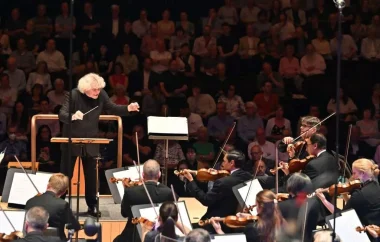
 United Kingdom Edinburgh International Festival 2023 [10]: Cynthia Miller (ondes Martenot) Peter Donohoe (piano), London Symphony Orchestra / Sir Simon Rattle (conductor). Usher Hall, 6pm and 8pm, 18.8.2023. (SRT)
United Kingdom Edinburgh International Festival 2023 [10]: Cynthia Miller (ondes Martenot) Peter Donohoe (piano), London Symphony Orchestra / Sir Simon Rattle (conductor). Usher Hall, 6pm and 8pm, 18.8.2023. (SRT)

The Road to Turangalîla
Dukas – Fanfare from La Péri
Milhaud – La création du monde
Debussy – La mer
Messiaen – Turangalîla Symphony
And it’s goodnight from him. This concert was Simon Rattle’s farewell to the Edinburgh International Festival as Music Director of the London Symphony Orchestra. As with his final Barbican concert, he chose to go out with one of the most uproariously over-the-top creations of twentieth-century music, Messiaen’s mighty Turangalîla Symphony. It is a work he adores and has long championed, and there is something appropriate about Rattle going out on a high with Messiaen’s gloriously ebullient hymn to universal love.
Part of me will never shake the suspicion that this whole piece is a massive joke, perpetrated on a musical world by a composer who is still laughing at us from beyond the grave. So unique is its soundworld and structure that it barely seems plausible. Rattle is completely sold on it, though, and the LSO gave the work its British premiere, so there could be no finer meeting of musical minds to bring the work to authentic life.
In their hands it glitters, bluster, swoops and wails. The sounds they create as they play it make it sound like both order and chaos forming and re-forming on the page, the piano and the ondes Martenot performing as principal characters in the drama, trying (and often failing) to impose order on a chaotic structure. Those instruments were played here by longtime Rattle collaborators Cynthia Miller and Peter Donohoe, Donohoe in particular played the fiendish piano part with all the vivacity and energy of a hyperactive teenage prodigy. The orchestral textures responded to both Messiaen and Rattle with ebullient vigour, with blazing brass and explosive percussion providing the ballast while the strings swooped and whirled through Messiaen’s impossible sound structure. The still centre of the work, the Jardin du sommeil d’amour, sounded intoxicatingly beautiful, with its gorgeous interplay of textures, themes, melody and birdsong, and the elation of the finale sounded like an uproariously jubilant dance, with the final victory handed to the unison love theme.
I am baffled as to why there was no programme booklet, though. Turangalîla isn’t a work that is particularly welcoming to newcomers, and there could well have been many listeners in the audience who were new to the piece and hoping to find out a bit about the turbulent journey they were about to go on. I sympathise with anyone who sat through it without a clue what was going on. Such an outcome is hardly in keeping with Nicola Benedetti’s stated aim of making the festival more accessible.
It is even more odd considering that, earlier in the evening, the programme for the predecessor concert told me all I ever wanted to know about music by Debussy, Milhaud and Dukas. Rattle preceded Turangalîla with another one-hour concert which he titled The Road to Turangalîla. His aim, he explained, was to use the music of Dukas, Milhaud and Debussy to explore what enabled Messiaen to write Turangalîla, from Milhaud’s use of jazz to Debussy’s creation of a new direction for what the symphony could do.
I wasn’t sold. These French predecessors may well have had an influence on Messiaen, but what is to say their influence was greater than that of, say, Ravel or, more potently, Wagner, whose use of the Tristan myth is an interesting chromatic parallel to Messiaen’s use of it in Turangalîla? There wasn’t enough explanation to convince me there was a link, so it is a good job they were all so well-played in and of their own right. Milhaud’s Création had an appealing wheezy-sleazy-take-it-easy feel to it, with a pleasingly consistent sense of teetering on the edge of chaos, while La mer showcased each component of the LSO in its glittering virtuosity while Rattle forged them all together into an organic whole.
So it’s farewell Sir Simon. He is a superb musician but, almost more importantly, a great ideas man. His concert couplings have often been inspired, even when they haven’t quite worked (I didn’t enjoy his Brahms Requiem earlier this week, though it was an interesting idea to pair it with Szymanowski’s Stabat Mater), and he has been a fearless champion of new and forgotten repertoire. And he has been a galvanising presence for musicians as well as for the place of music and music education in wider society. It is for those things, as much as for his conducting, that he will be missed, and for which we must hope he returns as a visitor. His Edinburgh concerts have been the highlights of several festival seasons, so let us hope he’s back on the podium, albeit with a different orchestra, before too long.
Simon Thompson
The Edinburgh International Festival runs at venues across the city until Sunday 27th August click here for details.
